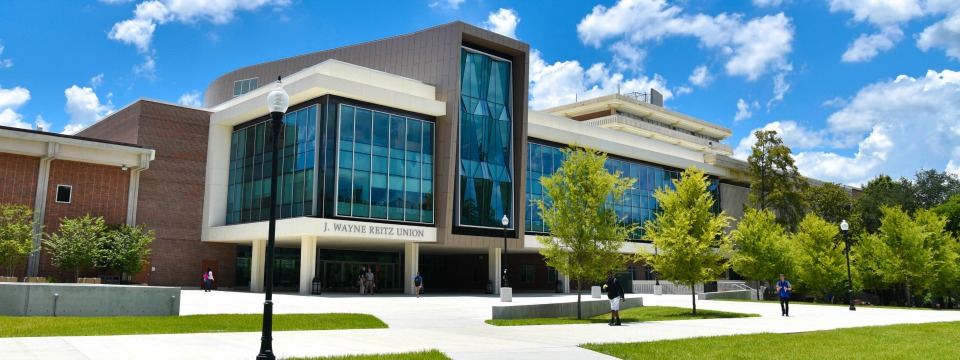Project Highlights
Location: Gainsville, Florida
Industry: Higher Education
Products Used: Controls, Air Handling
Services Used: Energy Analysis & Monitoring
Climate: Humid & Hot
Topic: Efficiency, Cost-Saving, Optimal Comfort

Challenge
Since its construction in 1965, the J. Wayne Reitz Union at the University of Florida had undergone numerous reconfigurations, resulting in a mix of architectural styles and stitched together systems. As administrators developed expansion plans to accommodate campus growth, they also wished to address the facility’s poor energy performance and comfort challenges. Infrastructure issues included aging air handlers, chiller plants that were not working together, and outdated pneumatic controls. The University sought to implement energy conservation measures (ECMs) that would deliver maximum savings and efficiency.
Solution
After a competitive selection process involving several vendors, the University of Florida selected Trane to implement a performance contract that would include significant infrastructure upgrades enabled by guaranteed energy savings. Project goals were to replace obsolete systems and increase capacity of the central cooling and heating plants, while conserving energy. Trane began by using the TRACE™ 700 modeling program to evaluate energy use of the HVAC and lighting systems. Relying on the Trane Building Advantage™ portfolio of energy services, Trane proposed a comprehensive renovation, with more than fifty potential ECMs.
Saving energy and maintenance costs
Fluorescent, metal halide and compact fluorescent fixtures were replaced with new LED fixtures throughout the facility. New LED fixtures were carefully selected to improve aesthetics and light quality. The LED's extended service life and dimming capability in high ceiling areas help to reduce maintenance time and costs. Performance contracting upgrades at J. Wayne Reitz Union increase capacity; projected to exceed guaranteed savings of 3,728,505 kWh of electricity, 13,597 therms of steam/yr, and result in first year savings of $535,657; receive $90,549 under an energy efficiency structure. The J. Wayne Reitz Union and surrounding complex includes the campus bookstore, ballrooms, auditoriums, meeting rooms, a food court, game room, office spaces, parking garage and a hotel with 36 guest rooms.
Optimizing building performance, increasing capacity
A redesign of the facility’s two chiller plants was implemented to optimize building performance. The chilled water piping between the two plants was redesigned to create a single primary-secondary pumping system. The chilled water pumping system was totally replaced and expanded to provide capacity for the new expansion. A refrigerant monitoring system was added in the chiller plant for improved safety.
The chiller plant was upgraded with a 2,000 kVA transformer, electrical service and switchgear, and the steam heating systems were replaced with a larger system to enable hot water flow throughout the complex. To provide sustainability, reliability and efficient operation, the existing chillers were replaced with two 500-ton Trane® CenTraVac™ centrifugal water-cooled chillers and a 375-ton Trane® Series S™ CenTraVac™ chiller that delivers the highest full- and part load efficiencies in its tonnage range.
Enhancing efficiency and comfort
Eleven constant-volume air handling units were replaced with more efficient variable-air-volume (VAV) Trane® Performance Climate Changer™ air handlers for primary cooling. Trane converted twenty recently installed constant-volume, multi- and single-zone air handling units to VAV and added VAV boxes, resulting in a substantial energy savings. Reconfiguring the system allowed the complete removal of five air handlers.
Improving operations and system control
New Building Automation Systems (BAS) replaced the non-communicating pneumatic controls and legacy systems. The University uses the BAS to access HVAC and lighting systems for scheduling, occupied/unoccupied settings, and night setback of cooling and heating setpoints. With an easy to operate, fully editable user interface set-up, building operators use the Trane chiller plant controls to start and stop the chillers and pumps based on system load; implement chiller, pump, and cooling tower sequencing and energy optimization routines; and obtain status reports of critical operating data.
Managing space and time constraints
With the energy retrofit taking place simultaneously with a major expansion and renovation project, daily coordination and intensive communication were required. Trane worked closely with facility managers to work within the space and time constraints, completing the work with minimal disruption to daily student activities and special events. Lighting retrofits in the ballroom were scheduled two months out awaiting an open date, a temporary air-cooled rental chiller provided cooling capacity during the chiller plant construction, and deliveries were planned to ensure loading dock availability for the bookstore, hotel and food service.
Results
The University of Florida and Trane implemented energy savings performance contracting upgrades at the J. Wayne Reitz Union, resulting in increased capacity and a project expected to exceed guaranteed savings. The upgrades are projected to result in an annual savings of 3,278,505 kWh of electricity and 13,597 therms of natural gas, annual energy use and rate change savings of $414,562, and annual operational savings of $121,095. The University also received an additional $90,549 under an energy efficiency structure. “This project made it possible for us to replace infrastructure without the financial burden of having to find new funds, and at the same time significantly reduced energy consumption," said Eddie Daniels, Executive Director, J. Wayne Reitz Union. "We are here to provide educational opportunities for students, and every upgrade and improvement enhances our ability to do that.”
































































































